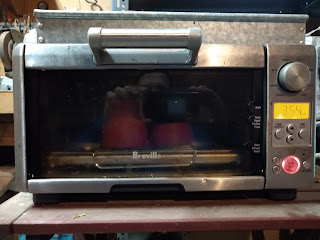How To Make Better Mistakes: Aluminum Casting No.4

After our last attempt at aluminum casting, we decided that what we needed to do, finally, was to make molds with proper venting, to allow the hot metal to enter more easily and fully. So we did that. [ some different vent/pour configurations, including a 'simian Venus' model ] We made the figures and prepared the molds for plaster. Then I burned out the molds in the toaster oven for about 3 hours, at a nice even temperature of around 125 degrees, so all the wax poured out and it didn't burn or stink too badly. And then we decided to put everything in the kiln as we had done in the last session , so the molds would have the same temperature as the molten metal. Except that we realized that we hadn't mixed the plaster with sand, so would it survive such high temperatures? It was just plain old Plaster of Paris... The answer? No. All the molds cracked. We had also forgotten to design the molds as we had previously, with a spot for an ...



